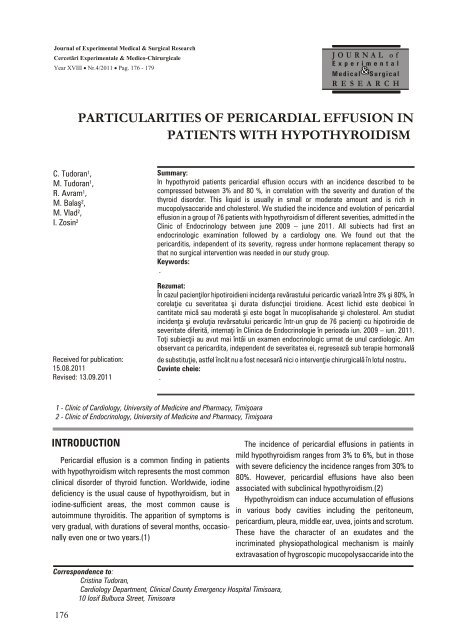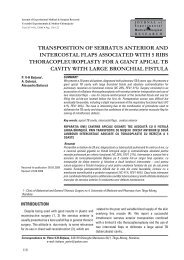particularities of pericardial effusion in patients with hypothyroidism
particularities of pericardial effusion in patients with hypothyroidism
particularities of pericardial effusion in patients with hypothyroidism
Create successful ePaper yourself
Turn your PDF publications into a flip-book with our unique Google optimized e-Paper software.
Journal <strong>of</strong> Experimental Medical & Surgical Research<br />
Cercetãri Experimentale & Medico-Chirurgicale<br />
Year XVIII Nr.4/2011 Pag. 176 - 179<br />
C. Tudoran 1 ,<br />
M. Tudoran 1 ,<br />
R. Avram 1 ,<br />
M. Balaº 2 ,<br />
M. Vlad 2 ,<br />
I. Zos<strong>in</strong> 2<br />
PARTICULARITIES OF PERICARDIAL EFFUSION IN<br />
PATIENTS WITH HYPOTHYROIDISM<br />
Received for publication:<br />
15.08.2011<br />
Revised: 13.09.2011<br />
1 - Cl<strong>in</strong>ic <strong>of</strong> Cardiology, University <strong>of</strong> Medic<strong>in</strong>e and Pharmacy, Timiºoara<br />
2 - Cl<strong>in</strong>ic <strong>of</strong> Endocr<strong>in</strong>ology, University <strong>of</strong> Medic<strong>in</strong>e and Pharmacy, Timiºoara<br />
INTRODUCTION<br />
Pericardial <strong>effusion</strong> is a common f<strong>in</strong>d<strong>in</strong>g <strong>in</strong> <strong>patients</strong><br />
<strong>with</strong> <strong>hypothyroidism</strong> witch represents the most common<br />
cl<strong>in</strong>ical disorder <strong>of</strong> thyroid function. Worldwide, iod<strong>in</strong>e<br />
deficiency is the usual cause <strong>of</strong> <strong>hypothyroidism</strong>, but <strong>in</strong><br />
iod<strong>in</strong>e-sufficient areas, the most common cause is<br />
autoimmune thyroiditis. The apparition <strong>of</strong> symptoms is<br />
very gradual, <strong>with</strong> durations <strong>of</strong> several months, occasionally<br />
even one or two years.(1)<br />
176<br />
JOURNAL <strong>of</strong><br />
Experimental<br />
Medical Surgical<br />
R E S E A R C H<br />
Summary:<br />
In hypothyroid <strong>patients</strong> <strong>pericardial</strong> <strong>effusion</strong> occurs <strong>with</strong> an <strong>in</strong>cidence described to be<br />
compressed between 3% and 80 %, <strong>in</strong> correlation <strong>with</strong> the severity and duration <strong>of</strong> the<br />
thyroid disorder. This liquid is usually <strong>in</strong> small or moderate amount and is rich <strong>in</strong><br />
mucopolysaccaride and cholesterol. We studied the <strong>in</strong>cidence and evolution <strong>of</strong> <strong>pericardial</strong><br />
<strong>effusion</strong> <strong>in</strong> a group <strong>of</strong> 76 <strong>patients</strong> <strong>with</strong> <strong>hypothyroidism</strong> <strong>of</strong> different severities, admitted <strong>in</strong> the<br />
Cl<strong>in</strong>ic <strong>of</strong> Endocr<strong>in</strong>ology between june 2009 – june 2011. All subiects had first an<br />
endocr<strong>in</strong>ologic exam<strong>in</strong>ation followed by a cardiology one. We found out that the<br />
pericarditis, <strong>in</strong>dependent <strong>of</strong> its severity, regress under hormone replacement therapy so<br />
that no surgical <strong>in</strong>tervention was needed <strong>in</strong> our study group.<br />
Keywords:<br />
.<br />
Rezumat:<br />
În cazul pacienþilor hipotiroidieni <strong>in</strong>cidenþa revãrastului pericardic variazã între 3% ºi 80%, în<br />
corelaþie cu severitatea ºi durata disfuncþiei tiroidiene. Acest lichid este deobicei în<br />
cantitate micã sau moderatã ºi este bogat în mucoplisaharide ºi cholesterol. Am studiat<br />
<strong>in</strong>cidenþa ºi evoluþia revãrsatului pericardic într-un grup de 76 pacienþi cu hipotiroidie de<br />
severitate diferitã, <strong>in</strong>ternaþi în Cl<strong>in</strong>ica de Endocr<strong>in</strong>ologie în perioada iun. 2009 – iun. 2011.<br />
Toþi subiecþii au avut mai întâi un examen endocr<strong>in</strong>ologic urmat de unul cardiologic. Am<br />
observant ca pericardita, <strong>in</strong>dependent de severitatea ei, regreseazã sub terapie hormonalã<br />
de substituþie, astfel încât nu a fost necesarã nici o <strong>in</strong>tervenþie chirurgicalã în lotul nostru.<br />
Cuv<strong>in</strong>te cheie:<br />
.<br />
Correspondence to:<br />
Crist<strong>in</strong>a Tudoran,<br />
Cardiology Department, Cl<strong>in</strong>ical County Emergency Hospital Timisoara,<br />
10 Iosif Bulbuca Street, Timisoara<br />
The <strong>in</strong>cidence <strong>of</strong> <strong>pericardial</strong> <strong>effusion</strong>s <strong>in</strong> <strong>patients</strong> <strong>in</strong><br />
mild <strong>hypothyroidism</strong> ranges from 3% to 6%, but <strong>in</strong> those<br />
<strong>with</strong> severe deficiency the <strong>in</strong>cidence ranges from 30% to<br />
80%. However, <strong>pericardial</strong> <strong>effusion</strong>s have also been<br />
associated <strong>with</strong> subcl<strong>in</strong>ical <strong>hypothyroidism</strong>.(2)<br />
Hypothyroidism can <strong>in</strong>duce accumulation <strong>of</strong> <strong>effusion</strong>s<br />
<strong>in</strong> various body cavities <strong>in</strong>clud<strong>in</strong>g the peritoneum,<br />
pericardium, pleura, middle ear, uvea, jo<strong>in</strong>ts and scrotum.<br />
These have the character <strong>of</strong> an exudates and the<br />
<strong>in</strong>crim<strong>in</strong>ated physiopathological mechanism is ma<strong>in</strong>ly<br />
extravasation <strong>of</strong> hygroscopic mucopolysaccaride <strong>in</strong>to the
ody cavities comb<strong>in</strong>ed <strong>with</strong> <strong>in</strong>creased capillary<br />
permeability, decreased lymphatic dra<strong>in</strong>age, and<br />
<strong>in</strong>creased retention <strong>of</strong> salt and water. The serum and<br />
<strong>effusion</strong>s <strong>in</strong> <strong>patients</strong> <strong>with</strong> <strong>hypothyroidism</strong> usually have<br />
high levels <strong>of</strong> cholesterol.<br />
AIM OF THE STUDY<br />
The aim <strong>of</strong> the study was to determ<strong>in</strong>e the <strong>in</strong>cidence <strong>of</strong><br />
<strong>pericardial</strong> <strong>effusion</strong> <strong>in</strong> hypothyroid <strong>patients</strong>. We also tried<br />
to establish if there is any correlation between the<br />
severity <strong>of</strong> the thyroid disorder, expressed through the<br />
level <strong>of</strong> thyroid hormones and the severity and evolution<br />
<strong>of</strong> pericarditis.<br />
MATERIAL AND METHOD<br />
Our study group consisted <strong>of</strong> 76 <strong>patients</strong> <strong>with</strong><br />
<strong>hypothyroidism</strong> admitted <strong>in</strong> the Cl<strong>in</strong>ic <strong>of</strong> Endocr<strong>in</strong>ology <strong>of</strong><br />
the County Emergency Hospital Timisoara, <strong>in</strong> a period <strong>of</strong><br />
3 years, between june 2009 – june 2011. In the study<br />
group there were 67 women and 9 men, aged between<br />
21 and 79 years (mean age= 42,21±23 years), 64 <strong>with</strong><br />
overt forms <strong>of</strong> <strong>hypothyroidism</strong> and 12 <strong>with</strong> subcl<strong>in</strong>ical<br />
disease.<br />
All the <strong>patients</strong> had first an endocr<strong>in</strong>ologic<br />
exam<strong>in</strong>ation, which consisted <strong>of</strong> hormonal<br />
determ<strong>in</strong>ations (thyroid stimulat<strong>in</strong>g hormone - TSH, free<br />
thyrox<strong>in</strong> - FT4, free triiodothyrox<strong>in</strong> - FT3) and sonography,<br />
<strong>in</strong> order to establish the etiology and severity <strong>of</strong> the<br />
thyroid disorder. Subsequently, they where evaluated by<br />
the cardiologist: history, physical exam<strong>in</strong>ation, ECG,<br />
chest x-ray and echocardiography done <strong>with</strong> an Acuson<br />
Sequoia C512 echocardiograph. On the<br />
echocardiographic exam<strong>in</strong>ation, we assesed the<br />
Table 1. Results <strong>of</strong> laboratory exam<strong>in</strong>ations.<br />
Results <strong>of</strong> laboratory<br />
exam<strong>in</strong>ation <strong>in</strong> 76 <strong>patients</strong><br />
• Chest X-ray:<br />
cardiomegaly<br />
• ECG: negative T wave<br />
ST segment changes<br />
• Pericardial <strong>effusion</strong>:<br />
Small<br />
Moderate<br />
Large<br />
• Tendency to diastolic right ventricular collapse<br />
• Sw<strong>in</strong>g<strong>in</strong>g heart<br />
• Thickened pericardium<br />
dimensions <strong>of</strong> the heart cavities, left ventricular function,<br />
the existance and degree <strong>of</strong> valvular disfunctions. We<br />
tried to establish the presence <strong>pericardial</strong> <strong>effusion</strong>, the<br />
volume and, if possible to appreciate the density <strong>of</strong> the<br />
<strong>effusion</strong>. With this exam<strong>in</strong>ation the hemodynamic<br />
consequences and the presence or absence <strong>of</strong><br />
tamponade were determ<strong>in</strong>ate.<br />
RESULTS AND DISCUSSIONS<br />
The etiology <strong>of</strong> <strong>hypothyroidism</strong> was <strong>in</strong> most <strong>of</strong> the<br />
cases autoimmune 71 <strong>patients</strong> (93.42%), 5 <strong>patients</strong><br />
(6.57%) had iatrogenic forms (after subtotal or total<br />
thyroidectomy) and 1 patient (1.31%) had congenital<br />
mixedema. Consider<strong>in</strong>g the severity <strong>of</strong> the symptoms<br />
and level <strong>of</strong> TSH and thyroid hormones the <strong>patients</strong> were<br />
divided <strong>in</strong> 3 subgroups: 12 <strong>patients</strong> (15.78%) <strong>with</strong><br />
subcl<strong>in</strong>ical <strong>hypothyroidism</strong> (elevated TSH, but normal<br />
peripheric thyroid hormones), 12 <strong>patients</strong> (15.78%) had<br />
overt <strong>hypothyroidism</strong> and 52 <strong>patients</strong> (68.42%) had<br />
mixedema.<br />
All <strong>patients</strong> underwent cl<strong>in</strong>ic and laboratory<br />
exam<strong>in</strong>ations and the results are presented <strong>in</strong> table1.<br />
We found that <strong>pericardial</strong> <strong>effusion</strong>s <strong>in</strong> <strong>hypothyroidism</strong><br />
had an <strong>in</strong>sidious onset, appeared <strong>with</strong>out significant<br />
hemodynamic changes, and echocardiography was the<br />
primary method <strong>of</strong> diagnosis. EKG characteristics <strong>of</strong><br />
<strong>pericardial</strong> <strong>effusion</strong>s <strong>in</strong>cluded low QRS voltage,<br />
PR-segment depression, ST-segment deviation, T-wave<br />
changes and electrical alternans.<br />
The <strong>in</strong>cidence <strong>of</strong> pericarditis <strong>in</strong> the 3 subgroups as<br />
presented <strong>in</strong> fig 1 is: 3 subjects (25%) from the <strong>patients</strong><br />
<strong>with</strong> subcl<strong>in</strong>ical <strong>hypothyroidism</strong> had small <strong>pericardial</strong><br />
<strong>effusion</strong>s, 4 <strong>patients</strong> (30%) from those <strong>with</strong> overt disease<br />
12 P Subcl<strong>in</strong>ical<br />
<strong>hypothyroidism</strong><br />
12 normal<br />
1<br />
3 - 25%<br />
3<br />
12 P <strong>with</strong> overt<br />
<strong>hypothyroidism</strong><br />
11 normal<br />
1 (mild)<br />
1<br />
1<br />
4 - 30%<br />
2<br />
2<br />
1<br />
52 P <strong>with</strong><br />
mixedema<br />
24 normal<br />
28<br />
12<br />
15<br />
32 – 61.53%<br />
18<br />
8<br />
6<br />
4<br />
3<br />
8<br />
177
had mild and moderate pericarditis, but 32 <strong>patients</strong><br />
(61.53%) <strong>with</strong> mixedema had pericarditis <strong>of</strong> different<br />
severity. Most <strong>of</strong> them 56.25% had small <strong>effusion</strong>s, 25%<br />
had moderate forms and only 6 <strong>patients</strong> (18.75%) had<br />
large <strong>effusion</strong>s, 4 <strong>of</strong> them <strong>with</strong> <strong>in</strong>cipient signs <strong>of</strong><br />
tamponade, wich remitted under hormone replacement<br />
therapy, so that no pericardocentesis was needed.<br />
Except for <strong>patients</strong> <strong>with</strong> prolonged <strong>hypothyroidism</strong>,<br />
<strong>pericardial</strong> <strong>effusion</strong> was m<strong>in</strong>or or moderate and the<br />
cardiac symptoms are alleviated <strong>with</strong> hormonal<br />
replacement therapy. Occasionally, <strong>pericardial</strong> <strong>effusion</strong><br />
was substantial and cardiomegaly was evident on chest<br />
X-ray.<br />
A peculiar aspect, found mostly <strong>in</strong> <strong>patients</strong> <strong>with</strong><br />
mixedema was a thickened pericardium. This aspect was<br />
found <strong>in</strong> 25% <strong>of</strong> the <strong>patients</strong> and was probably caused by<br />
long last<strong>in</strong>g or/and repeated episodes <strong>of</strong> mixedematous<br />
pericarditis.<br />
Pericardial <strong>effusion</strong> tends to regress slowly and<br />
disappear several weeks or months after the <strong>patients</strong><br />
were reverted to euthyroid status.(3) Repeated<br />
178<br />
Fig. 1. Incidence <strong>of</strong> <strong>pericardial</strong> <strong>effusion</strong> <strong>in</strong> the 3 subgroups.<br />
Fig. 2. Regression <strong>of</strong> <strong>pericardial</strong> <strong>effusion</strong> under replacement therapy.<br />
echocardiographic exam<strong>in</strong>ation performed after 1, 3 and<br />
6 month <strong>of</strong> replacement hormonal therapy revealed<br />
graduate reduction <strong>of</strong> <strong>pericardial</strong> <strong>effusion</strong> <strong>in</strong> concordance<br />
<strong>with</strong> the improvement <strong>of</strong> the thyroid dysfunction as<br />
presented <strong>in</strong> fig2.<br />
Pericardial tamponade is a rare presentation <strong>of</strong><br />
<strong>hypothyroidism</strong> and has been found <strong>in</strong> most cases only<br />
after many years <strong>of</strong> symptomatic <strong>hypothyroidism</strong> or <strong>in</strong><br />
<strong>patients</strong> who did not respond well to replacement<br />
therapy.(4) It has been thought that the size <strong>of</strong> the<br />
<strong>pericardial</strong> <strong>effusion</strong> depends on the severity and duration<br />
<strong>of</strong> <strong>hypothyroidism</strong> and most cases <strong>of</strong> tamponade have<br />
been reported <strong>in</strong> the elderly.<br />
However, hypothyroid <strong>patients</strong> <strong>with</strong> hemodynamically<br />
significant <strong>pericardial</strong> <strong>effusion</strong>s may not always have<br />
prom<strong>in</strong>ent symptoms and signs <strong>of</strong> <strong>hypothyroidism</strong>, such<br />
as weight ga<strong>in</strong>, weakness, edema, slow mentation etc.<br />
The diagnosis <strong>of</strong> <strong>hypothyroidism</strong> <strong>in</strong> the elderly is difficult<br />
because <strong>of</strong> its slow onset, and the cl<strong>in</strong>ical signs and<br />
symptoms are usually subtle and non-specific.
CONCLUSIONS<br />
1. The etiology <strong>of</strong> <strong>hypothyroidism</strong> was <strong>in</strong> most<br />
<strong>of</strong> the cases autoimmune;<br />
2. The <strong>in</strong>cidence and amount <strong>of</strong> <strong>pericardial</strong><br />
<strong>effusion</strong> <strong>in</strong> mixedema correlates <strong>with</strong> the severity and<br />
duration <strong>of</strong> disease;<br />
3. Pericardial <strong>effusion</strong> due to <strong>hypothyroidism</strong><br />
regresses slowly under hormonal replacement therapy;<br />
4. Sometimes a thickened pericardium was<br />
found mostly <strong>in</strong> <strong>patients</strong> <strong>with</strong> mixedema.<br />
References:<br />
1. Gregory A, Brent P, Larsen R, et al. In: Kroneberg (ed), Williams’ Textbook <strong>of</strong> Endocr<strong>in</strong>ology. 11th ed, Philadelphia, W. B.<br />
Saunders Co., 2008; pp. 384-387.<br />
2. McDermott MT. In the cl<strong>in</strong>ic. Hypothyroidism. Ann. Intern. Med. 2009; 151: ITC61.<br />
3. Wei-Syun Hu, Sh<strong>in</strong>-Huang Lee, Chung-Yen Huang: Massive Amount <strong>of</strong> Pericardial Effusion Secondary to Hashimoto’s<br />
Thyroiditis: A Case Report. Formos J Endocr<strong>in</strong> Metab 2009; 1: 29-32<br />
4. Kle<strong>in</strong> I, Danzi S. Thyroid disease and the heart. Circulation 2007; 116: 1725–35.<br />
179




